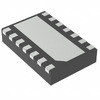Manufacturer Part Number
TLIN2027DRQ1
Manufacturer
Texas Instruments
Introduction
The TLIN2027DRQ1 is an automotive AEC-Q100 qualified LIN transceiver.
Product Features and Performance
Supports LIN protocol
Interface between LIN master/slave nodes and the physical bus
Provides robust communication in harsh automotive environments
Integrated slope control for reduced electromagnetic emissions
Under-voltage detection and thermal shutdown protection
Dominant state detection feature
Product Advantages
Highly integrated with minimal external components
Robust ESD performance
Wide operating voltage and temperature range suitable for automotive applications
Key Technical Parameters
Single LIN transceiver (1 Driver/Receiver)
Data Rate: 20 kbps
Voltage - Supply: 4V to 48V
Receiver Hysteresis: 200 mV
Operating Temperature: -40°C to 125°C
Qualification standard: AEC-Q100
Quality and Safety Features
Built-in protection against voltage spikes
Compliant with LIN physical layer specification 2.0, 2.1, 2.2, and SAE J2602
Thermal shutdown with auto-restart
Fail-safe features ensure communication in event of bus faults
Compatibility
Seamless interface with LIN protocol controllers and physical bus
Application Areas
Automotive electronics
Body control modules
Sensors and actuators communication
In-vehicle networks
Product Lifecycle
Current Product Status: Active
Not nearing discontinuation
Availability of replacements or upgrades will follow Texas Instruments product evolution
Several Key Reasons to Choose This Product
Automotive-grade product with AEC-Q100 qualification ensuring reliability in automotive applications
Wide input voltage range compatible with 12V and 24V automotive systems
High-temperature operation capability making it suitable for under-hood applications
The device facilitates low electromagnetic interference (EMI) for automotive electromagnetic compatibility (EMC) requirements
Texas Instruments' strong support and documentation for ease of integration and design
Ensures interoperability with existing LIN systems and future-proof for next-generation designs
Low-power consumption suitable for battery-operated subsystems within vehicles



 TLIN24413DMTTQ1Texas Instruments
TLIN24413DMTTQ1Texas Instruments TLIN14415DMTRQ1Texas InstrumentsIC TRANSCEIVER FULL 1/1 14VSON
TLIN14415DMTRQ1Texas InstrumentsIC TRANSCEIVER FULL 1/1 14VSON TLIN2029ADRBRQ1Texas InstrumentsFAULT PROTECTED LOCAL INTERCONNE
TLIN2029ADRBRQ1Texas InstrumentsFAULT PROTECTED LOCAL INTERCONNE TLIN2022ADRQ1Texas InstrumentsFAULT PROTECTED DUAL LOCAL INTER
TLIN2022ADRQ1Texas InstrumentsFAULT PROTECTED DUAL LOCAL INTER TLIN2029DRBRQ1Texas InstrumentsIC TRANSCEIVER 1/1 8VSON
TLIN2029DRBRQ1Texas InstrumentsIC TRANSCEIVER 1/1 8VSON TLIN2022DRQ1Texas InstrumentsIC TRANSCEIVER 2/2 14SOIC
TLIN2022DRQ1Texas InstrumentsIC TRANSCEIVER 2/2 14SOIC